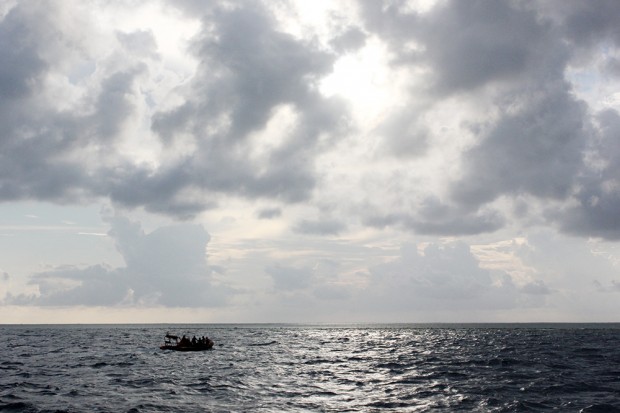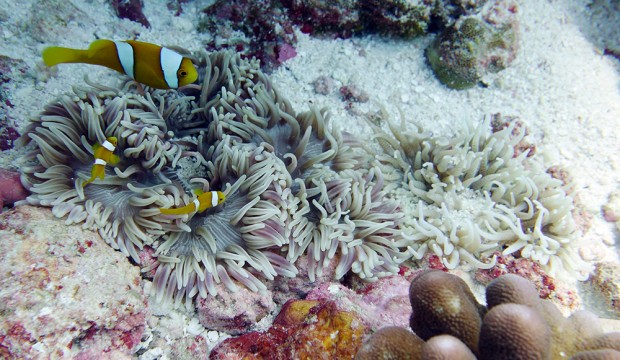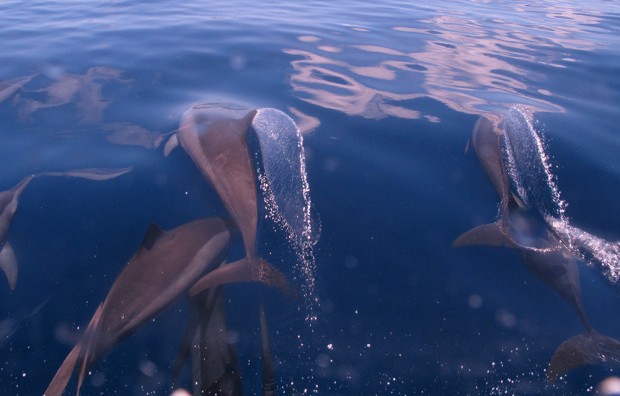2015 Darwin Science Expedition - Day 17 On to Bienheim

Having wrapped up our work at Salomon Atoll we motored away this morning toward Blenheim Reef, a submerged atoll that reaches all the way to the sea surface but doesn’t have any islands, being completely awash at high tide. The marine life over here is particularly rich with a seabed covered in a diverse blend of soft and hard corals, algae and sponges. Amongst and over a multitude of fish gather. Not to mention the turtles and dolphin that we saw through the day.

The first dive site was on the western coast of the atoll and the divers returned to the research vessel with reports of macroalgae beds growing up from the depths to about 15 meters and thereafter cyanobacteria carpeting the reef into the shallows. Unusual for this sort of dominance from plants in a place where so many grazing fish and such healthy corals generally predominate – a mystery for certain.

This was in marked contrast to the second dive on the SW corner. Here the blend of soft and hard corals predominated and beautiful schools of pyramid butterflyfish and surgeons polka dotted the water. A lazy nurse shark cruised by after a turtle had greeted us on arrival into the water.

A second dive on the SE corner of the atoll proved to be very similar although it offered up some treats. A fine pair of short-head anemone shrimp living on an unusual anemone – cryptodendrum adhaesivum – appeared just beneath courtney’s transect tape. Around them several smaller shrimp – thor amboinensis scuttled around and just above them a tiny nudibranch. Whilst we were admiring this fine collection of tiny inhabitants some far larger ones made their presence known. I was distracted by whistling sounds through the water. I swum to the drop off but this time around that was the wrong direction as I later discovered the Ronan and John who were finishing their dive in the shallows saw the culprits up close and personal. Dolphin! Disappointed to have missed them this time around. They’re always such wonderful creatures to see underwater.
VIDEO https://www.youtube.com/watch?v=JBqYbxED66k
Nevertheless I wasn’t to be disappointed for long. Back on the research vessel we set a course for Nelsons Island and I fired up the compressors to fill our scuba tanks for tomorrow. As I was watching the horizon between tanks a pod of thirty or so dolphin came gambolling out of the swells to our port. Evidently done feeding for the day they were up for a sundown play in the bow wave of our cruising boat and stayed with us for 20 minutes effortlessly keeping pace with our cruising vessel. These bottlenose dolphin included some large individuals – really impressive to see them jumping and playing within inches of the hull at times. A fine sight for the last rays of the sun to illuminate! After a day on such a productive reef now is a good time to get an update on Chris' carbon budget work...read on...

Salomon Atoll
We sailed from Peros Banhos to Salomon Atoll late on the afternoon of Sat 28th March, drifting in over the shallow northern lip of the atoll before nightfall. This is a much smaller, but equally beautiful atoll, ringed by wooded islands of varying size, the largest being Ile Boddam in the south-west. Over the first few days of diving here we worked on the western/north-western side of Salomon, at several sites along the seaward sides of Ile Anglaise and at Ile de Passe. These sites are on the more “sheltered” side of Salomon, and were very similar in character to those on the western side of Peros Banhos; with large tabular Acropora colonies visually dominant, but with a range of other compact, branched Acropora, smaller massive colonies and encrusting coral forms also present. These reefs again support populations of large (in excess of 50-60 cm) parrotfish.


Over the next few days we also worked on reefs along the more exposed southern/south-eastern margins. Weather conditions were good, but with the long period wave swell that was present these sites were challenging to study, with significant surge making the surveying very time consuming. These sites, at Ile Takamaka and Ile du Sel, were varied in character, but again rather similar to those on the exposed side of Peros Banhos, with low relief or hardground type habitats being characteristic and which were colonised by a range of robust branched or small massive corals.

A distinguishing feature of the Salomon lagoon is the presence of numerous reef knolls or pinnacles, which rise from the lagoon floor to near sea level. These knolls are relatively steeply sided and, although rather different to our other sites, were included for study due to their numerical abundance. Generally the waters appear relatively turbid, but the knolls have high coral cover and the coral communities are incredibly diverse, with high carbonate production rates measured.

A major, not entirely work-related, highlight of Salomon was the opportunity to be in the water with dolphins and Manta Rays; whilst surveying at Ile de Passe we were visited by a pod of 6-7 dolphins who came for a look-see, and then a few days later we had 6 large Manta’s come round the boat off Ile Anglais – the opportunity to get in and swim with them being too great to miss …. a fantastic way to end the Salomon part of the trip. We now move to the last phase of the expedition – a set of mostly 1 day stops at various sites as we loop back around the top of the Great Chagos Bank towards Diego Garcia.


From Salomon we sailed via Blenheim Reef for a single dive on the reefs west side and then down to the Great Chagos Bank the last major area of study. Our plan was to work from sites along the northern side of the Bank, a vast and largely submerged platform, and then via a series of sites along the western margins where a number of reef islands have formed. The Great Chagos Bank proved to be an area of great contrasts in terms of reef health and coral cover, this variability reflecting the different stages that the Chagos reefs are currently in regarding their recovery from recent disturbance events.
Our first study site was at Nelson Island – a rather depressing but very interesting site – dominated visually by large stands of entirely dead table corals, and whilst these were typically covered in juvenile coral recruits, overall coral cover was very low (<5%). All of the substrate at this site showed evidence of intense biological erosion and recorded, by some distannce, the low carbonate budget states of the trip thus far. Many of these corals appear to have died from a combination of disease, which we have observed to be affecting tablular Acropora colonies elsewhere, and from a recent outbreak of Crown-of-Thorns starfish … although we only observed one such starfish on our dive.


From Nelson we moved on to spend several days at The Brothers, South, Middle and North, where reef condition was much more similar to that observed at some of the better sites around Salomon and Peros Banhos, with wonderful cover of large tabular and branching coral Acropora, but also a wealth of other species on the upper reef terraces. As with all of the sites visited parrotfish have proved to be extremely abundant, and with many large terminal phase fish present at all sites. Diving conditions in The Brothers were challenging for the work that Gary and I do due to strong swell conditions, but between these sites and the Nelson site, the full spectrum of reef states out here can be seen over a relatively small spatial scale.
After the Brothers we have moved south, taking in various sites around Eagle Island, the western side of which had relatively low coral cover at all sites and a high abundance of coral rubble, then a site on the Danger Island. The weather by know had turned quite rough and very high waves and strong swell limited our ability to work on the western coast, but a site on the eastern side was workable in the afternoon. The unusual site of 16 Eagle Rays swimming in formation greeted us as we swam down to set up our transect lines.
Our final research day was spent on the Egmont Islands. The windy/swelly conditions have stayed with us, but a final site was surveyed along the north-east of this small atoll. Whilst this site had quite high cover of corals there was also a very large amount of dead in-situ and rubble Acropora present, and a mix of dead and live table corals present. This was another site with a lot of big fish, no sharks (that we observed) but a lot of big grouper, large parrotfish, large triggerfish, and at the end of the dive a chance to watch an octopus foraging in and around the coral rubble fields.
Tonight we head back to Diego Garcia for a several days of kit clearing and tidying. It has been a fantastic trip, and a great opportunity to study the carbonate budgets on these really remote reefs. Overall, I guess we have been surprised by the variability we have observed in reef health and thus in the budget state of the reefs, but the sites we have worked on have enabled us to look at the Chagos reefs not only where they occur in states of high and thriving coral cover but also, importantly, where they have been widely perturbed over the last few years by a combination of disease and predation. This will allow us to explore the natural cycles and drivers of coral carbonate production and bioerosion as coral cover rises and falls. Perhaps a key observation is that, almost without exception, we have seen evidence for widespread establishment of juvenile corals and for multiple phases of new coral recruitment at our study sites – an observation that suggests significant resilience within the reef systems here generally. We have, however, also recorded prolonged high temperatures (30oC) whilst diving throughout our 4 week long trip, and whilst they are no widespread signs of coral bleaching the persistence of such high temperatures would be of clear concern. The dataset we have now established will, however, provide a unique baseline for future monitoring of reef budget states, both at sites currently at the “healthy” end of the spectrum, and those that have recently been degraded – hopefully the opportunity for temporal monitoring of these states will arise in the future.

